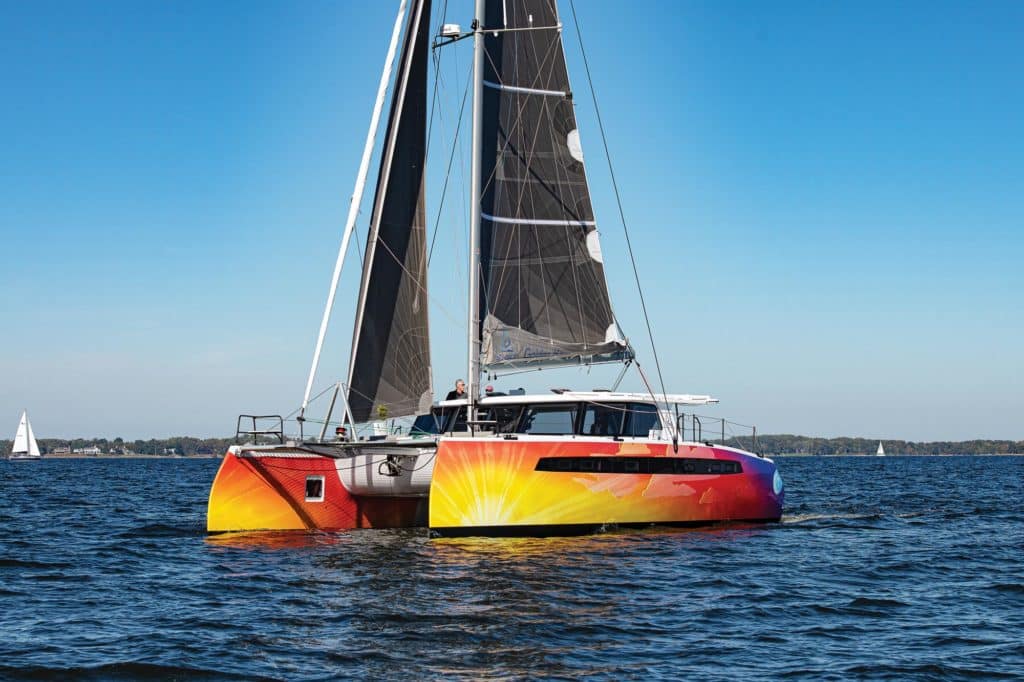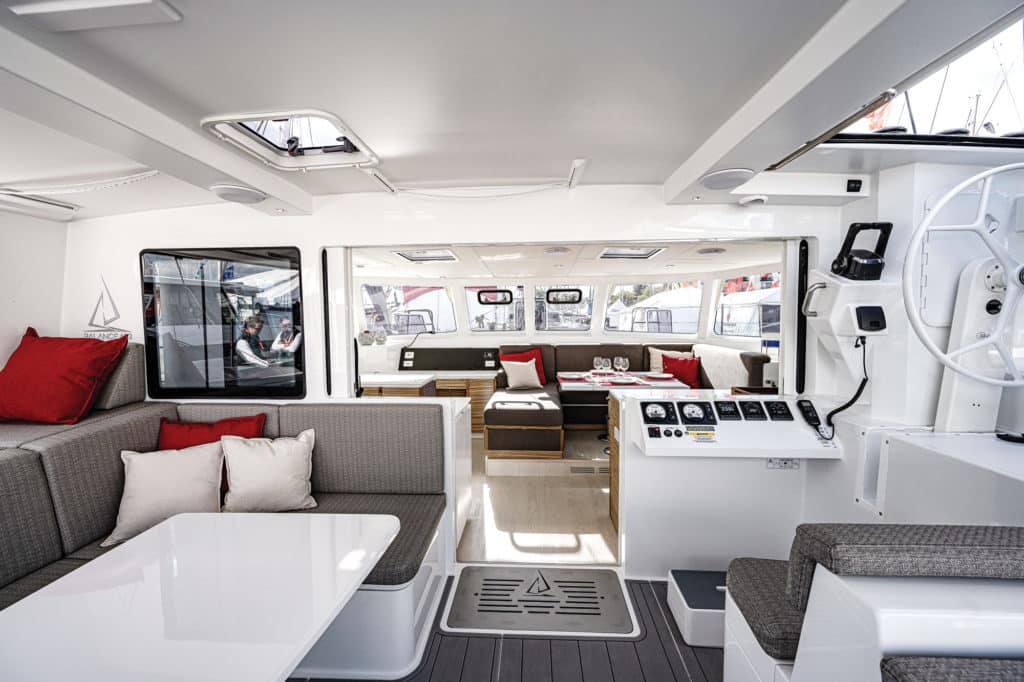Sailing World Magazine’s annual Boat of the Year tests are conducted in Annapolis, Maryland, following the US Sailboat Show. With independent judges exhaustively inspecting the boats on land and putting them through their paces on the water, this year’s fleet of new performance-sailing boats spanned from small dinghies to high-tech bluewater catamarans. Here’s the best of the best from our 2022 Boat of the Year nominees »
Life, like sailing, is all about balance, says Phil Berman, who, as a teenage Hobie class champion, wrote the authoritative book on catamaran racing. That was way back in the 1980s, but for our Boat of the Year tests, he’s on board the tropical-sunset-wrapped Balance 482 performance catamaran. This South African-built 48-footer is a sabbatical cruiser for sure, but it’s just the sort of cruiser a competitive sailor like Berman would just as well take across a starting line and go for the hardware.
His story may sound familiar, but it’s also the story of this boat. He started a multihull brokerage long ago, and after surveying and selling so many boats, he came to the inevitable conclusion: “I said, ‘You know, I think I can design a better production catamaran, one that isn’t designed for the charter trade, but one that’s going to be a boat that’s as comfortable to sail as it is on anchor.”
That’s the equilibrium Berman strives to achieve in all of his boats, and it is this lens through which our judges evaluated Hull No. 1 of the Balance 482 in Annapolis. “This is a boat that’s fun to sail, but has space to live and is robust enough to sail in the Southern Ocean,” he tells the judges, “and easily sailed singlehanded, if required.”
And with that said, he draws the judges’ attention to the boat’s helm station—the one and only—to starboard. Here, he shows them how he has full command of the engine throttles, and sail trim controls and halyards led through banks of low-profile clutches to three powered winches. Every line—literally every line—leads to this workspace, with the tails disappearing neatly into line boxes. From this vantage point at the helm, he can also see everything forward and above without having to look through a dodger or crazed vinyl. Such protection from the elements, Berman says, isn’t necessary. When the wind and water in your face get to be too much, you can simply disengage the plunger lock on the pedestal and pivot your helm downward into the salon, where there’s a bank of instruments at the ready and great visibility through the boat’s gigantic thick-glass windows.

The Versa Helm, which Berman says he invented and others have adopted, places the inside steering station in the aft cockpit, unlike many other catamaran designs that have the inside helm forward, next to a door that leads to a mast pit and cockpit. With the helm station located aft instead, the Balance’s salon can better utilize the space to fit an expansive galley, a roomy nav station desk, and a convertible queen-size berth when the dinette table is lowered. With dual 48-volt alternators, rigid solar panels on the roof, and all the low-draw galley appliances you could ever possibly need, this is a boat where you could certainly keep the fuel tanks light for racing and disappear off the grid for a while when you’re done banging around the buoys.
“The open layout in the salon is a nice change from what we normally see,” Greg Stewart says. “The up-down steering system actually worked really well, and it was an interesting place to steer a catamaran like this—it was something we’d never done on any of the other cats we’ve sailed. Because you don’t have all the friction of a second helm, the steering was amazingly light and responsive.”
At roughly 26,000 pounds (the stated weight with the cruise-package equipment), the judges deemed the light-ship displacement was about right for a boat of its length and purpose. Cored vinylester hulls and composite cabinetry throughout the interior help keep the weight down while allowing for storage compartments that practically run stem to stern in both hulls. “We’re not doing our laminate schedules on the thin edge of survival,” Berman tells the judges. “We’re building a boat that’s robust and capable of sailing in the Southern Ocean.”

The philosophy of the 482, he adds, is that a couple (“typically in their 50s and 60s”) would be capable of taking the boat on extended cruises or daysailing it with ease. For the latter purpose, the 82 percent working jib is self-tacking, and the 964-square-foot mainsail is set on a bridle instead of a transom-mounted traveler. “Rather than dealing with a traveler, you set the bridal stoppers for the wind you have,” Berman says, “and with that, you can short-tack all day long.”
The 482’s ability to tack efficiently and track well upwind is mainly due to the deep, high-profile carbon daggerboards, Stewart says. “The foil profiles are good, and the boards are plenty deep.”
The judges sail-tested the boat with the working jib in 6 to 10 knots of breeze, and Chuck Allen felt it was a bit underpowered, but Stewart said a few more knots of breeze would have made it come alive. Even with the small jib, the boat was matching wind speeds, he adds, and sailing at decent angles upwind. When they rolled out the screecher—no surprise—the fun meter shot up instantly.
Furling spinnakers, of course, require careful handling to ensure a proper roll, and on the Balance, there’s good working space on the foredeck to snake and stow these sails. Berman points to the raised aluminum longeron as a key feature; it eliminates a tripping hazard on the forward trampoline and provides a wide and firm runway to access headsail tack fittings.
Approximately 35,000 man-hours go into making the Balance as strikingly good-looking on the outside as it is inside, and squeezed into 25 feet of beam are sophisticated systems that are all easily accessible for maintenance, from the steering quadrant, to the engines and alternators, to the watermaker and the meticulous electric panel.
“The interior is what really struck me as being really, really well done,” Dave Powlison says. “It fits into the luxury category, with the beautiful wood laminate and all the high-quality systems. The hull lines too were perfectly clean without any bump-outs [for the steps down into the hulls], and that also makes it a lot quieter.”
Allen agrees: “The whole boat is really clean, everywhere I looked. And I thought, for the boat we saw, it would be a lot more than $1.3 million. It hits its stated purpose, and for me, the value is what put this one to top of my list. The balance that [Berman] talks about—good sailing and good livability—definitely makes this one a winner.”









